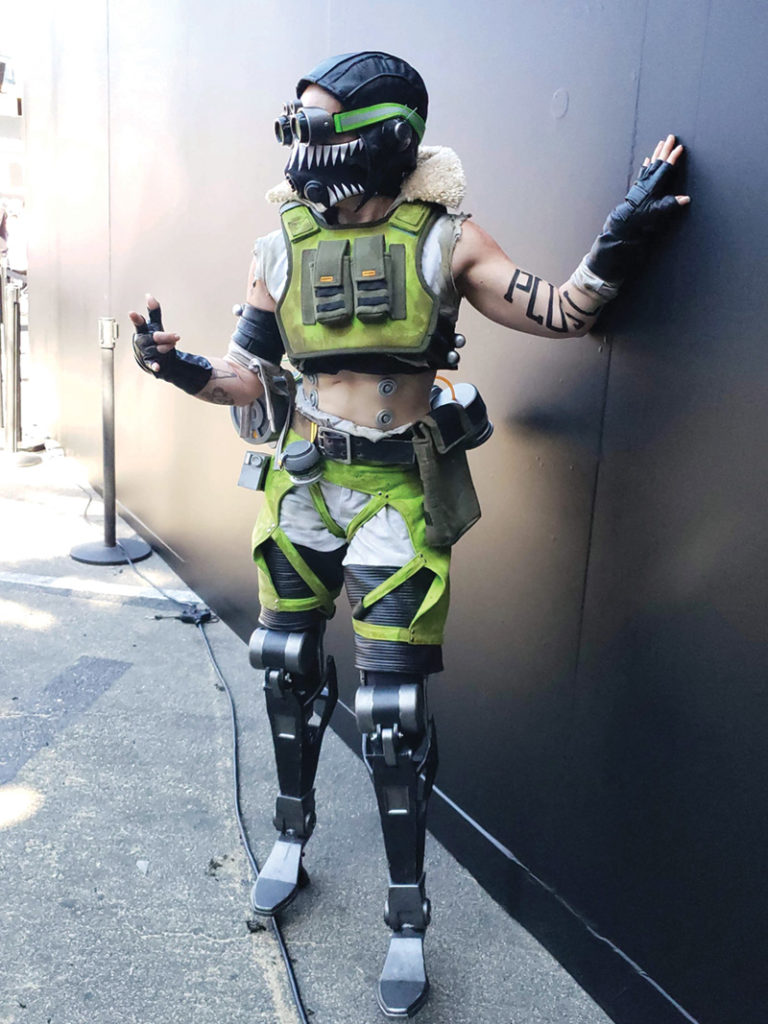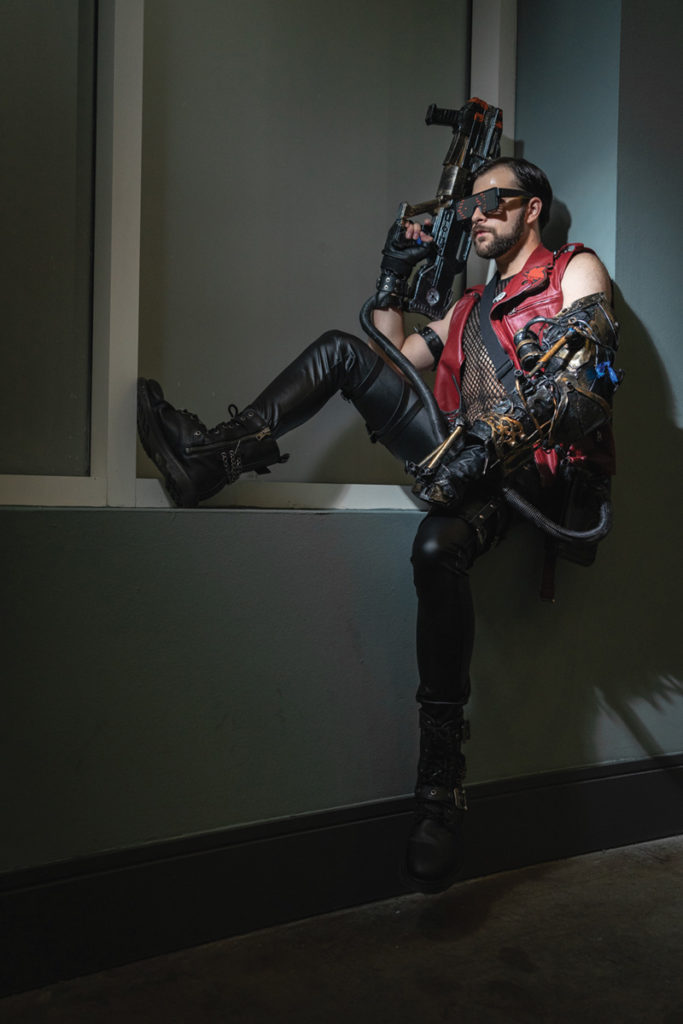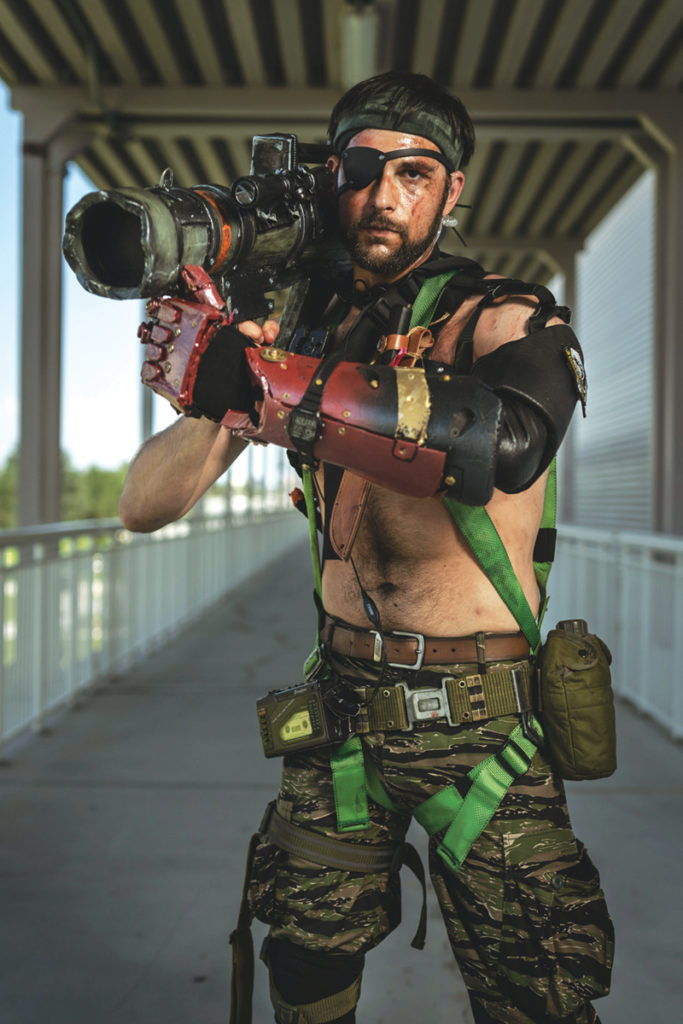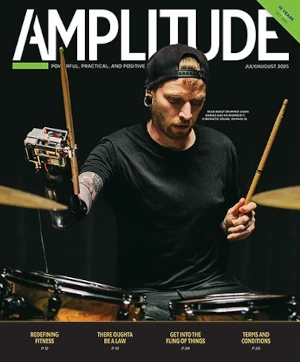By Eric Quander
Finding Fun, Confidence, Understanding, and Community Through Cosplay

We love our superheroes.
It seems the only movies guaranteed to get butts in the theater seats these days involve some type of glowing saber, super sorcerer, or teen-aged avenger fighting against a faceless nemesis bent on threatening what’s left of our right to life, liberty, and the pursuit of happiness—our humanness. According to the age-old formula, the heroic masked or caped crusaders inevitably discover something about themselves through the relationships they experience with both friends and foes. The characters in these alternative realities deeply impact audience members in different ways. Some are so affected by the journey of the hero who strikes them deepest that they take to dressing like them.
As an amputee, I was at first intrigued by what might motivate other amputees to join the costumed community of cosplayers but have since come to understand it better. Although it might seem a bit weird for adults to spend a significant amount of time and money and to travel great distances to attend the cosplay conventions of their dreams, I have discovered that cosplay is not the frivolous nerdfest I’d thought. In fact, there are many benefits and opportunities for those with a cause to cosplay.
When I was approached with the idea of writing about amputee cosplayers, I was completely prejudiced. Don’t get me wrong. The topic was interesting, but I have to admit that a part of me thought, “Oh, great. I get to jump headfirst into a pool of leather, lace, and spikes, surrounded by nerds wielding swords and saying in horrible Lord-of-the-Rings-esque accents, “You shall not pass!” So, I had to take a different approach. As an actor, I could relate to the ability of costume to help an artist get into character. Instead of looking at cosplayers as social rejects needing to escape the reality of their mothers’ basements or studio apartments, I would consider them artists getting all De Niro-esque in their work of dressing up like characters. I determined that I would consider cosplay as performance.

Cosplay, the practice of dressing up as a character from a movie, book, video game, or comic book, especially one from the Japanese genres of manga and anime, has spawned an entire industry of conventions, memorabilia, and costumes. Participation costs can be in the thousands of dollars, not to mention the sweat equity that many invest to get their costumes just right. Some spend a year rewinding movies and referring to dog-eared pages of comics to get the exact shade of Deadpool’s crimson tights or the details of Diana Prince’s Amazonian bracelets. Costumes may include electronic devices, wigs, fake beards, tattoos, body art, jewelry, weapons, and prostheses.
Jay Rosen is an artist and developer at OPIE Software—a company dedicated to improving the quality of care received by millions of amputees and orthotic patients worldwide. His inspirations from working in the O&P field combined with his passion for crafting sculptures motivated him to create his own prostheses to cosplay as his favorite characters from movies and video games. Rosen worked all year living a healthier lifestyle with a consistent diet, exercise, and supplementation to lose more than 35 pounds, striving to attain the physique of the heroic characters he wanted to portray.
“Cosplay is a fun activity that everyone can enjoy–regardless of age, gender, skin color, disability, or body type,” says Rosen. “Cosplay is a way of transforming into the person you always wanted to be, regardless if your role model was a real person or from a work of fiction. We might not be able to fly, but that shouldn’t stop anyone from striving to be like Superman or Captain Marvel.”
Uber-fans dressing as their favorite characters can be traced back to the beginning of sci-fi conventions when attendees mainly dressed up like Trekkies or characters from Battlestar Galactica. But what started off as a few hundred participants with glued-on plastic ears and cardboard phasers has grown into thousands.
Many participants consider themselves introverts and confess that dressing up allows them to be more outgoing. Wearing a costume seems to give them the confidence and permission to step outside of themselves and be as bold, courageous, sexy, or villainous as they desire. Most definitely, cosplayers have a passion for costumes, and the dedication that amputee cosplayers have is evident as they incorporate their differently abled bodies into the characters they often choose to inhabit.

While amputees are not limited to portraying characters with limb loss, they appear to have an affinity for and share several characteristics with their amputee alter egos in varying degrees: emotional fragility induced by trauma, the use of tools and prosthetic devices, and a dis-ease with their inability to be accepted as social beings. The emotional trauma that many amputees face is similar to that of the DC character Batman, who as a child witnessed his parents’ murder and now heroically battles the repercussions. Batman’s ongoing evolution includes intense physical and mental training and the development of an intestinal fortitude to crusade for his perception of what is right and just. “In the video game Metal Gear Solid V: The Phantom Pain, the main characters deal with limb loss or PTSD [post-traumatic stress disorder] in different ways,” says Rosen, who has cosplayed the amputee character Venom Snake from the game. As can be the case with actual amputees, in addition to the inner demons fictional characters must face as a result of traumatic events, they often come to recognize the necessity of holding on to their humanness at all costs.
Robin S. Rosenberg, a clinical psychologist at the University of California, San Francisco, writes about how people relate to fictional characters. In a Live Science article published in 2016 (www.livescience.com/56641-why-people-cosplay.html), she said, “We know from psychology that we all play different roles through the day and week…. I became curious about people who truly inhabit a role, and what’s coming to the fore when you wear a costume.” Like the Caped Crusader, some of those who choose to cosplay as Batman may have experienced their own traumatic experience and may have discovered a purpose through their experience.
One of the biggest challenges for amputees and the characters in the fiction mags and stories they choose to portray is coming to terms with how they connect with and exercise their unique abilities. We see entire movie franchises whose characters must balance their uniqueness in the midst of a world of “normies”—an experience many amputees can identify with. Just as we may experience in our everyday lives, these characters are presented opportunities to affect the lives of those who may view them as freaks of nature. One path can lead you to being regarded as a super-being in your community, while another path can lead you to a painful experience that has you hell-bent on destroying the universe around you.
Many amputee cosplayers seem to connect with their alter ego’s grappling with that balance. The variety of characters that amputees portray range from the brooding, hard-edged lone wolf to the seemingly innocent doe-eyed pixie that can summon the power of a supernova with an incantation or snap of the fingers. Characters like the Hulk and the X-Men’s Beast demonstrate the perception that the individual cannot be limited to what we see physically. Looking different from everyone else can be an opportunity to manifest all of the characteristics that set you apart from the mean.
A cosplay convention brings together personalities and characters from the farthest stretches of the universe to create community.
“[These] events are not just for nerds,” says Rosen. “Millions of people flock to these pop-culture events to meet their favorite celebrities and participate in a multitude of activities, workshops, and meetups.”
Enthusiastic cosplayers can quickly find themselves embraced by people who share their interest in the multitude of characters and universes in which they exist. The feeling of acceptance is something that many cosplayers express as a reason for their involvement in the community. Your background, job, education level, personal appearance, or missing limbs don’t really matter. Like the Justice League or He-Man and his motley crew, individuals find themselves making genuine relationships based on a shared passion for the fantastical and ideal.
This understanding on my part was one of my aha moments. Cosplay is just another form of church—a vehicle for like-minded individuals to establish a connection to someone who may share their vision for a better world. As amputees, we forge ahead with the spirit that we will not be judged on how similar our bodies and experiences may be to others but by those qualities that make us unique and a valuable resource of love and abundance in the world. There is a cause in our play—to exhibit the strength, beauty, and intelligence that make us unique and deserving.
FOR MORE INFORMATION
SCHEDULE OF COSPLAY-RELATED EVENTS
CYBERPUNK 2077 COSPLAY CONTEST
www.cyberpunk.net/en/cosplay-contest
This contest offers a total prize pool of $40,000 for the best costumes. Deadline: November 30



